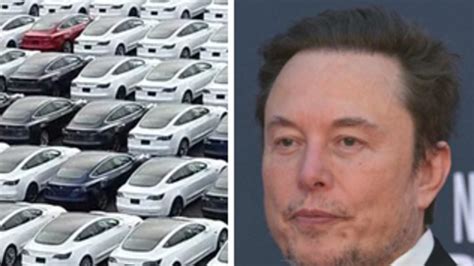
Tesla’s vehicle deliveries fell sharply in the first quarter of 2024, significantly missing Wall Street estimates and raising concerns about waning demand, production challenges, and the impact of CEO Elon Musk’s polarizing public image. The electric vehicle giant delivered 386,810 vehicles, a substantial drop from the anticipated 449,080 and well below the 422,875 delivered in the same period last year. This marks the first year-over-year decline since the pandemic-hit 2020 and the largest delivery miss relative to expectations in the company’s history.
The disappointing figures, revealed Tuesday, sent Tesla’s stock tumbling in pre-market trading, fueling anxieties about the company’s growth trajectory and competitive positioning in an increasingly crowded EV market. Several factors are contributing to the decline, including production halts at the Gigafactory Berlin due to arson, supply chain disruptions stemming from the Red Sea crisis, and the ongoing transition to an updated Model 3. However, analysts also point to the potential impact of Musk’s controversial statements and political leanings on consumer perception of the brand.
“We believe the Musk brand is tarnishing the Tesla brand,” said Gene Munster of Deepwater Asset Management, echoing a sentiment that’s becoming increasingly prevalent among investors and industry observers. This delivery miss raises serious questions about Tesla’s ability to maintain its dominant position in the EV market, particularly as established automakers and new entrants ramp up their electric vehicle offerings.
Production Versus Deliveries: A Growing Discrepancy
While deliveries plummeted, Tesla’s production remained relatively stable, reaching 433,371 vehicles in the first quarter. This divergence between production and deliveries highlights a critical issue: Tesla is producing more cars than it can currently sell. This growing inventory buildup suggests weakening demand and could force Tesla to implement further price cuts, which would further erode profit margins.
The Model 3/Y accounted for the bulk of production and deliveries, with 412,376 vehicles produced and 369,783 delivered. The higher-priced Model S/X saw significantly lower numbers, with 20,995 produced and only 17,027 delivered. This disparity underscores the challenges Tesla faces in maintaining demand for its higher-end vehicles.
Tesla attributed part of the delivery shortfall to “factory shutdowns resulting from shipping diversions caused by the Red Sea conflict and the arson attack at Gigafactory Berlin.” The Red Sea crisis has disrupted global shipping routes, forcing vessels to take longer and more expensive detours, while the Gigafactory Berlin incident temporarily halted production, impacting the availability of vehicles in Europe.
However, many analysts believe these disruptions are only part of the story. “The Red Sea issue and the Berlin factory fire certainly had an impact, but they don’t fully explain the magnitude of the delivery miss,” argued Daniel Ives of Wedbush Securities. “There’s clearly a demand issue at play here, and Tesla needs to address it aggressively.”
The Musk Factor: A Double-Edged Sword
Elon Musk has long been considered Tesla’s greatest asset, his visionary leadership and relentless pursuit of innovation driving the company’s meteoric rise. However, his increasingly controversial public statements and political pronouncements are now seen by some as a liability.
Musk’s outspoken views on topics ranging from politics and social issues to artificial intelligence and space exploration have alienated some potential customers. His acquisition of Twitter (now X) and subsequent changes to the platform have also drawn criticism, with many users and advertisers expressing concerns about content moderation and the spread of misinformation.
“Musk’s behavior is becoming a real problem for Tesla,” said Ross Gerber, CEO of Gerber Kawasaki Wealth & Investment Management, a Tesla investor. “He’s alienating potential customers, and it’s starting to impact the company’s bottom line.” Gerber has publicly called on Tesla’s board of directors to rein in Musk’s public pronouncements, arguing that they are damaging the brand.
While it’s difficult to quantify the precise impact of Musk’s image on Tesla’s sales, there is growing evidence that it is a factor. A recent survey by Morning Consult found that Tesla’s brand favorability had declined among Democrats and Independents, while remaining relatively stable among Republicans. This suggests that Musk’s increasingly conservative political leanings are turning off some potential buyers.
However, it’s important to note that Musk’s influence isn’t entirely negative. He remains a charismatic figure to many, and his vision for the future continues to inspire investors and customers alike. “Musk is still a huge asset for Tesla,” said Gene Munster. “He’s a brilliant innovator, and he’s built an incredible company. But he needs to be more mindful of the impact his words and actions have on the brand.”
Competitive Pressures: The EV Market Heats Up
Tesla’s delivery woes come at a time of intensifying competition in the EV market. Established automakers like General Motors, Ford, and Volkswagen are investing heavily in electric vehicles, and new entrants like Rivian, Lucid, and BYD are also vying for market share.
These competitors are offering a wider range of electric vehicles at various price points, giving consumers more choices than ever before. Tesla, which once enjoyed a near-monopoly in the EV market, now faces a much more challenging landscape.
“The EV market is becoming increasingly competitive,” said Jessica Caldwell, executive director of insights at Edmunds. “Tesla can no longer rely on its brand alone to drive sales. It needs to innovate and offer compelling products that can compete with the growing number of electric vehicles on the market.”
One area where Tesla is facing increased competition is in the affordable EV segment. Companies like BYD are offering electric vehicles at significantly lower prices than Tesla, making them attractive to budget-conscious consumers. This price competition is putting pressure on Tesla to lower its prices, which could further erode profit margins.
Pricing Strategy: Walking a Tightrope
Tesla has a history of adjusting its pricing strategy to stimulate demand. In recent years, the company has implemented several price cuts across its model lineup, making its vehicles more accessible to a wider range of customers.
However, these price cuts have also come at a cost, eroding Tesla’s profit margins. In the first quarter of 2023, Tesla’s gross profit margin fell to 19.3%, a significant decline from the 29.1% reported in the same period last year.
Analysts are divided on whether Tesla should continue to lower its prices. Some argue that price cuts are necessary to maintain market share, while others believe that they are unsustainable in the long run.
“Tesla needs to find a balance between pricing and profitability,” said Adam Jonas, an analyst at Morgan Stanley. “They can’t keep cutting prices forever. At some point, they need to focus on improving their efficiency and reducing their costs.”
Future Outlook: Challenges and Opportunities
Tesla faces a number of challenges in the coming months, including weakening demand, intensifying competition, and the ongoing impact of Musk’s public image. However, the company also has several opportunities to turn things around.
One key opportunity is the ramp-up of production at the Gigafactory Berlin. Once the factory is fully operational, it will significantly increase Tesla’s production capacity in Europe, allowing the company to better meet demand in the region.
Tesla is also working on new products, including the Cybertruck, which is expected to begin deliveries later this year. The Cybertruck is a highly anticipated vehicle, and it could generate significant buzz and boost Tesla’s sales.
The company continues to invest heavily in research and development, particularly in areas such as autonomous driving and battery technology. These investments could lead to breakthroughs that give Tesla a competitive edge in the future.
“Tesla is still a very innovative company,” said Gene Munster. “They have a lot of potential to create new products and technologies that will disrupt the automotive industry. But they need to navigate these challenges carefully and focus on executing their strategy.”
Expert Analysis and Investor Reactions:
The news of Tesla’s delivery shortfall triggered a flurry of analysis from industry experts and reactions from investors, reflecting a mix of concern and calls for strategic adjustments. Many analysts emphasized the need for Tesla to address the demand side more effectively. Wedbush Securities analyst Daniel Ives, maintaining a “Neutral” rating on Tesla, stated, “While we were expecting a weak number, this was a Titanic-like quarter that is hard to defend.” He pointed to a combination of factors, including logistical challenges and softening demand, but stressed the urgency for Tesla to “right the ship.”
Gene Munster of Deepwater Asset Management offered a more critical assessment, directly linking Elon Musk’s public image to the company’s struggles. “We believe the Musk brand is tarnishing the Tesla brand,” Munster noted, suggesting that the board needs to consider steps to mitigate this impact.
Investor sentiment, predictably, turned negative. The stock price experienced a sharp decline in pre-market trading, underscoring the market’s disappointment with the results. Some investors expressed concern about the long-term implications of the delivery miss, questioning whether Tesla can maintain its high growth trajectory in the face of increasing competition. Others remained optimistic, emphasizing the company’s technological advantages and its potential to recover in the coming quarters.
Tesla’s Official Statement:
In its official statement, Tesla acknowledged the challenges faced during the quarter, attributing the delivery shortfall to external factors, particularly disruptions to production and shipping. The company highlighted the impact of the Red Sea conflict, which forced shipping diversions and increased transit times, and the temporary shutdown of Gigafactory Berlin due to an arson attack. Tesla also noted that it was in the process of ramping up production of the updated Model 3, which contributed to the lower delivery numbers.
However, the statement did not directly address the issue of demand or the potential impact of Elon Musk’s public image. This omission drew criticism from some analysts, who argued that Tesla needs to be more transparent about the underlying factors affecting its performance.
Broader Implications for the EV Industry:
Tesla’s struggles have implications beyond the company itself, raising questions about the overall health of the EV industry. While electric vehicles continue to gain market share, growth rates appear to be slowing in some regions. This could be due to a variety of factors, including high interest rates, economic uncertainty, and range anxiety among potential buyers.
The challenges faced by Tesla also highlight the importance of supply chain resilience and the need for automakers to diversify their production and sourcing. The Red Sea crisis and the Gigafactory Berlin incident demonstrated the vulnerability of global supply chains to unforeseen events.
Furthermore, Tesla’s experience underscores the importance of brand management and the potential risks associated with having a highly visible and controversial CEO. As the EV market becomes more competitive, automakers will need to focus on building strong brands and cultivating positive relationships with consumers.
The Road Ahead:
The coming quarters will be crucial for Tesla. The company needs to address the issues that contributed to the delivery shortfall, including demand weakness, production disruptions, and the impact of Elon Musk’s public image.
Tesla also needs to continue to innovate and develop new products that can compete with the growing number of electric vehicles on the market. The Cybertruck is a key product in this regard, and its successful launch could provide a significant boost to Tesla’s sales.
Finally, Tesla needs to improve its efficiency and reduce its costs. This will be essential for maintaining profitability in an increasingly competitive environment. Whether Tesla can successfully navigate these challenges remains to be seen.
FAQ:
1. Why did Tesla’s vehicle deliveries decline in Q1 2024?
Tesla’s vehicle deliveries declined in Q1 2024 due to a combination of factors, including factory shutdowns related to shipping diversions caused by the Red Sea conflict, an arson attack at Gigafactory Berlin, the transition to an updated Model 3, and potentially weakening demand influenced by CEO Elon Musk’s public image. The company delivered 386,810 vehicles, significantly below Wall Street estimates of around 449,080.
2. How does Tesla’s production volume compare to its delivery volume in Q1 2024?
In Q1 2024, Tesla produced 433,371 vehicles while delivering only 386,810. This indicates that Tesla is producing more vehicles than it is currently selling, leading to an increase in inventory. This discrepancy signals potential demand issues.
3. What impact is Elon Musk’s public image having on Tesla’s sales?
Some analysts and investors believe that Elon Musk’s increasingly controversial public statements and political leanings are negatively impacting Tesla’s brand and sales. His outspoken views have alienated some potential customers, particularly among Democrats and Independents, according to surveys. Gene Munster of Deepwater Asset Management stated, “We believe the Musk brand is tarnishing the Tesla brand.”
4. How is increasing competition in the EV market affecting Tesla?
The EV market is becoming increasingly competitive, with established automakers and new entrants offering a wider range of electric vehicles at various price points. This increased competition is putting pressure on Tesla to innovate, lower prices, and maintain market share. Companies like BYD are offering more affordable EVs, challenging Tesla’s dominance.
5. What are Tesla’s plans to address the delivery shortfall and maintain its position in the EV market?
Tesla plans to ramp up production at Gigafactory Berlin, introduce new products like the Cybertruck, and continue investing in research and development, particularly in autonomous driving and battery technology. The company also needs to address the demand issue and find a balance between pricing and profitability to maintain its position in the EV market. They’ll need to navigate supply chain vulnerabilities and build stronger brand loyalty.









